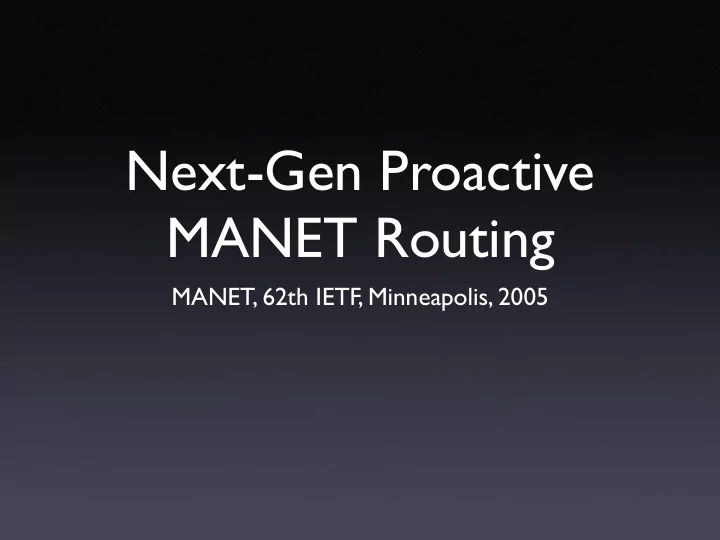

Next-Gen Proactive MANET Routing MANET, 62th IETF, Minneapolis, 2005
Status • Background: • experiences from RFC3626, RFC3648, misc I-Ds • Design team: • “vocal” implementers/users of proactive protocols • Activities thus far: • gather experience • ponder components • write design-documents • not (yet) draft writing....
Design “Dogmas” • Flexible and extensible where sensible: • external extensibility - new message types • internal extensibility - add information to existing msgs • Unification of concepts/messages: • e.g.: OLSR TC, HNA, MID • e.g.: OLSR HELLO, MID • Maintain/respect IP architecture • The “Graduate Student Criteria”
Design “Dogmas” • Keep basic case (e.g. single if/address) simple • while supporting complete case (e.g. multi if, multi- address) • Std. track specification will contain: • normative for interoperability • example algorithms/parameters • Based strictly on “known stuff” • but accommodating for future extensions • Efficiency - but not at all costs
Basic Protocol Functioning • Basic link-state protocol • Optimized flooding • Local-scoped signaling (HELLOs) • topology maintenance (link, neighbor detection) • forwarder/relay signaling, etc • Global-scoped signaling (TCs) • Inject link-state information to all nodes
Control Traffic • Making statements about addresses: • “there’s a link between me and.....” • “this property is associated with.....” • Possible properties: • “sym”, “asym”, “cost”, “DR-selection”, “flooding relay selection”, “security association”.... ‣ Address block & TLV association • inspired by OSPFv2 LLS
Address Block & TLV • Example: • {<address-block><tlv1><tlv2><tlv3><tlv4><tlv5>} • <tlv> can apply: • to single address • to sequence of addresses • to all addresses E.g.: OLSR HELLO • to message message TLVs: • Unknown TLVs: ignored SYM, ASYM, MPR
Addresses • An address is a sequence....any sequence...of bits • IPv4 - 32bit, IPv6 - 128bit • other lengths: bluetooth, sensor, ... • Most nodes share the same, long, prefix ‣ Flexible, compressible address representation: address-block • {<address-length><head-length><head>{<tails>+}}
IPv6 support • More than just longer addresses: • multiple addresses/node: the norm • link-local addresses: • useless in MANETs • not advertised or routed • supported for IPv6 “legacy” support • unique local addresses, global addresses • advertised & routed within MANET • no advertisements outside MANET
Tasks & Thoughts • Simplify multiple address/interface case • Possible separation between flooding relay & “DR” designation • Support for different msg. interval models: • exponential backoff, periodic, fuzzy/fsr, ... • Support for != mandated behavior
Near-term schedule • -00 draft: ~2-4 weeks after IETF • compilation of design-doc’s • well-iterated by design-team • Possible informal documents (I-Ds ?): • design rationales / considerations • best practice • “exotic extension X implemented thus....”
Recommend
More recommend